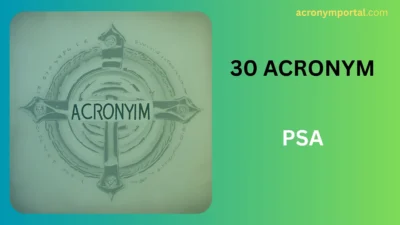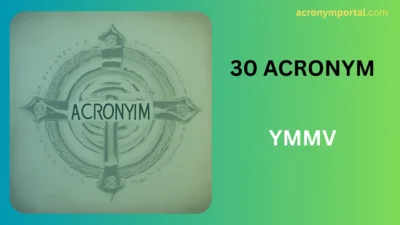In the world of abbreviations, the terms “initialism” and “acronym” are often tossed around interchangeably—but they’re not the same thing.
Whether you’re writing professionally, designing a brand, or just trying to sound a bit smarter in your daily communication, understanding the difference between an initialism and an acronym can make a big impact.
In this article, we’ll:
- Define what initialisms and acronyms are
- Explain their key differences
- Provide 30 real-world examples (15 each)
- Highlight when and why to use one over the other
- Offer tips on tone, context, and clarity
Let’s decode the difference once and for all. 🧠
🔍 What’s the Difference Between an Initialism and an Acronym?
| Term | Definition | Example | Pronounced As |
| Acronym | An abbreviation formed from initial letters and pronounced as a word | NASA (National Aeronautics and Space Administration) | “nass-uh” |
| Initialism | An abbreviation formed from initial letters, but each letter is spoken separately | FBI (Federal Bureau of Investigation) | “F-B-I” |
➡️ All acronyms are abbreviations, but not all abbreviations are acronyms.
➡️ If you say the letters, it’s an initialism.
➡️ If you say it like a word, it’s an acronym.
📘 15 Common Acronym Examples (With Usage Tips)
1. NASA – National Aeronautics and Space Administration
🗣 “NASA launched another Mars rover.”
Use when: Referencing the U.S. space agency in general writing or casual speech.
2. SCUBA – Self-Contained Underwater Breathing Apparatus
🗣 “He’s getting certified in scuba diving.”
Use when: The acronym has become a common noun.
3. RADAR – Radio Detection and Ranging
🗣 “The plane disappeared from the radar screen.”
Use when: The acronym has become fully integrated into speech.
4. LASER – Light Amplification by Stimulated Emission of Radiation
🗣 “She used a laser pointer during her presentation.”
Use when: The technical term has become widely accepted.
5. UNESCO – United Nations Educational, Scientific and Cultural Organization
🗣 “UNESCO sites are protected heritage areas.”
Use when: Referencing formal institutions.
6. NATO – North Atlantic Treaty Organization
🗣 “NATO responded swiftly to the crisis.”
Use when: Talking about international military alliances.
7. OPEC – Organization of the Petroleum Exporting Countries
🗣 “OPEC decisions impact global oil prices.”
Use when: Economic or geopolitical writing.
8. SWAT – Special Weapons And Tactics
🗣 “A SWAT team was deployed.”
Use when: Emergency, crime, or military contexts.
9. MADD – Mothers Against Drunk Driving
🗣 “MADD campaigns against impaired driving.”
Use when: Advocacy and nonprofit references.
10. COVID – Coronavirus Disease
🗣 “COVID changed global travel norms.”
Use when: Discussing the 2019 pandemic.
11. PIN – Personal Identification Number
🗣 “Don’t share your ATM PIN.”
Use when: Financial or digital security contexts.
12. GIF – Graphics Interchange Format
🗣 “She replied with a funny GIF.”
Use when: Online media or digital communication.
13. LIDAR – Light Detection and Ranging
🗣 “LIDAR helps self-driving cars navigate.”
Use when: Tech and innovation topics.
14. SNAFU – Situation Normal: All Fouled Up
🗣 “The whole project turned into a SNAFU.”
Use when: Military slang, now casual/humorous tone.
15. SIM – Subscriber Identity Module
🗣 “I switched my SIM card to a new phone.”
Use when: Mobile technology or telecommunications.
📗 15 Common Initialism Examples (With Usage Tips)
1. FBI – Federal Bureau of Investigation
🗣 “The FBI is investigating the case.”
Use when: Law enforcement topics.
2. USA – United States of America
🗣 “She was born in the USA.”
Use when: Patriotic or formal references.
3. CEO – Chief Executive Officer
🗣 “The CEO announced the new direction.”
Use when: Business or corporate settings.
4. ATM – Automated Teller Machine
🗣 “I need to find an ATM.”
Use when: Everyday banking language.
5. HTML – HyperText Markup Language
🗣 “HTML is the backbone of web pages.”
Use when: Web design and tech.
6. UFO – Unidentified Flying Object
🗣 “They claimed to see a UFO last night.”
Use when: Science fiction or aviation discussions.
7. BBC – British Broadcasting Corporation
🗣 “The BBC aired a new documentary.”
Use when: Media or journalism contexts.
8. IQ – Intelligence Quotient
🗣 “He has a high IQ score.”
Use when: Psychological or academic topics.
9. ID – Identification
🗣 “Show your ID at the entrance.”
Use when: Legal or security settings.
10. URL – Uniform Resource Locator
🗣 “Click the URL to access the page.”
Use when: Online directions or tutorials.
11. CPU – Central Processing Unit
🗣 “Your CPU affects your computer’s speed.”
Use when: Tech and hardware writing.
12. DIY – Do It Yourself
🗣 “She’s great at DIY home projects.”
Use when: Crafts, lifestyle, or informal tone.
13. VPN – Virtual Private Network
🗣 “Use a VPN to browse securely.”
Use when: Internet privacy and cybersecurity.
14. FAQ – Frequently Asked Questions
🗣 “Check the FAQ section before emailing support.”
Use when: Websites, help docs, and guides.
15. IRS – Internal Revenue Service
🗣 “The IRS sent a tax notice.”
Use when: Government and finance contexts.
🤔 When to Use Acronyms vs Initialisms
| Consideration | Use Acronym | Use Initialism |
| Pronunciation | If it sounds like a word (e.g. NATO, SCUBA) | If each letter is said separately (e.g. FBI, CEO) |
| Tone | Informal, natural-sounding | Formal or technical |
| Clarity | When the full form is widely known | When precision matters |
| Writing Style | Conversational or brand-friendly | Business, tech, or legal writing |
💡 Pro Tip: Some terms evolve from initialism to acronym as usage changes (e.g. “COVID” started as an initialism, but is now commonly said like a word).
🎯 Conclusion
Understanding the difference between acronyms and initialisms is more than a grammar lesson—it’s about communicating clearly and confidently. Whether you’re building a presentation, writing for your brand, or posting online, using the correct abbreviation boosts credibility and keeps your message crisp.
Remember:
- Acronyms = Say it like a word
- Initialisms = Say each letter
- Context is key! ✨
Keep this guide handy and you’ll never mix them up again. 💼🧩




